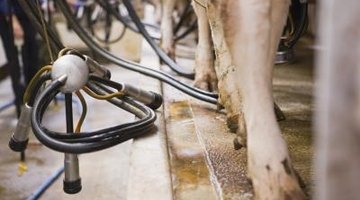Parts of a Milking Machine
Milking machines extract milk from cows. These machines cause less stress for the cow and damage teats less often. The milking machines also reduce the risk of inflammatory infection. While older milking machines often caused damage to the cow teats, the invention of the pulsator in 1980 lead to safer automated cow milking. The latest milking machines use computerized technology to regulate milk suction.
Teat Cups

The farmer attaches teat cups to the cow's teats for protection. The vacuum tube creates the suction that draws the milk out of the cow's teats. The milking machine has four teat cups for the four teats that cows have. They have an inner rubber liner and an outer metal shell. The teat cup has a thin inner rubber liner and a thicker rubber liner within the tube. This teat cup has two chambers: one inside the liner and one between the metal shell and the outside liner.
Tubes
The milk leaving the cow's teats travels down the claw. The milk then travels from the claw to the milk tube. The vacuum tube provides constant negative pressure that draws the milk from the gland. When the vacuum tube enters the rest phase, the air entering the tube collapses the rubber liner, massaging the teat and maintaining the blood flow. The teat-end vacuum has 11 to 12 inches of mercury. Incorrect vacuum settings, flooded milk lines and uneven milk-out quarters create air leaks that can cause teat-end vacuum fluctuations. Farmers can identify this phenomenon by a vacuum sound.
Milk Tank
The suction created by the vacuum brings the milk to a collecting bowl at the bottom of the claw. The milk then flows through a tube to the milk tank. The farmers usually house the milk tank in a separate room from the rest of the milking machine.
Pulsator
The milking machine automatically turns on and off via the pulsator. The pulsator ensures that blood and lymph do not accumulate near the teat, causing damage to the teat. Some milking systems automatically remove the teat cups after the milking machine has extracted all of the milk so that the machine does not damage the cow teat. The farmer should clean the pulsators with regularity to ensure that they function properly.
Computers
Milking machines use advanced computer software to keep track of the cow milking and to also control the milking machine. The farmer can look at the logs and determine what's wrong with the milking machine. When the flow of milk slows down, the milking machines automatically slow down the suction and detach the teat cups from the cow's teats.
References
Writer Bio
Charles Pearson has written as a freelancer since 2009. He has a B.S. in literature from Purdue University Calumet and is currently working on his M.A. He has written the ebooks "Karate You Can Teach Your Kids," "Macadamia Growing Handout" and "The Raw Food Diet."
Photo Credits
- Jupiterimages/BananaStock/Getty Images
More Articles
- How to Get Rid of Wolf Spiders in the House
- How to Remove a Hose from a Dyson DC15 Ball Vacuum
- Trouble in Removing the Back Filter Cover of a Kenmore Progressive Vacuum Cleaner
- Jura Capresso E8: Troubleshooting Guide
- How to Keep Water From Getting Stagnant in a Toilet Tank
- Delonghi Caffe Treviso Instructions



